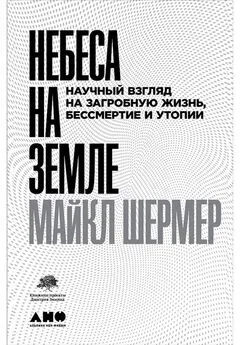Майкл Мобуссин - Больше, чем вы знаете. Необычный взгляд на мир финансов
- Название:Больше, чем вы знаете. Необычный взгляд на мир финансов
- Автор:
- Жанр:
- Издательство:Array Литагент «Альпина»
- Год:2014
- Город:Москва
- ISBN:978-5-9614-3247-3
- Рейтинг:
- Избранное:Добавить в избранное
-
Отзывы:
-
Ваша оценка:
Майкл Мобуссин - Больше, чем вы знаете. Необычный взгляд на мир финансов краткое содержание
Больше, чем вы знаете. Необычный взгляд на мир финансов - читать онлайн бесплатно ознакомительный отрывок
Интервал:
Закладка:
Johnson, Norman L. “Biography.” http://ishi.lanl.gov.
____. “Collective Problem Solving: Functionality Beyond the Individual.” LA-UR-98–2227, 1998.
____. “Diversity in Decentralized Systems: Enabling Self-Organizing Solutions.” LA-UR-99–6281, 1999.
____. “What a Developmental View Can Do for You (or the Fall of the House of Experts).” Выступление на Форуме новаторов в CSFB, сентябрь 2000 г., Санта-Фе, Нью-Мексико http://www.capatcolumbia.com/CSFB%20TLF/2000/johnson00_ sidecolum.pdf.
Johnson, Steven. Emergence: The Connected Lives of Ants, Brains, Cities, and Software. New York: Scribner, 2001.
Joseph de la Vega. Confusion de Confusiones. 1688.
Kahneman, Daniel. “Maps of Bounded Rationality: A Perspective on Intuitive Judgment and Choice.” Нобелевская лекция, прочитана 8 декабря 2002 г. http://www.nobel.se/economics/laureates/2002/kahnemann-lecture.pdf.
Kahneman, Daniel, and Amos Tversky. “Prospect Theory: An Analysis of Decision Under Risk.” Econometrica 47 (1979): 263–91.
Kahneman, Daniel, Paul Slovic, and Amos Tversky, eds. Judgment Under Uncertainty: Heuristics and Biases. Cambridge: Cambridge University Press, 1982.
Kauffman, Stuart. At Home in the Universe. Oxford: Oxford University Press, 1996.
Kaufman, Michael T. Soros: The Life and Times of a Messianic Billionaire. New York: Knopf, 2002. Kaufman, Peter D., ed. Poor Charlie’s Almanack. Virginia Beach, Va.: The Donning Company Publishers, 2005.
Kennedy, James, and Russell C. Eberhart. Swarm Intelligence. San Francisco: Morgan Kaufmann, 2001.
Keynes, John Maynard. The General Theory of Employment. New York: Harcourt, Brace and Company, 1936.
Klein, Gary. Sources of Power: How People Make Decisions. Cambridge, Mass.: MIT Press, 1998.
Klepper, Steven. “Entry, Exit, Growth, and Innovation Over the Product Life Cycle.” American Economic Review 86, no. 3 (1996): 562–83.
Knight, Frank H. Risk, Uncertainty, and Profit. Boston: Houghton and Mifflin, 1921. http://www.econlib.org/library/Knight/knRUP.html.
Koch, Richard. The 80/20 Principle: The Secret to Success by Achieving More with Less. New York: Currency, 1998.
Kranhold, Kathryn. “Florida Might Sue Alliance Capital Over Pension Fund’s Enron Losses.” The Wall Street Journal, April 23, 2002.
Krugman, Paul. The Self-Organizing Economy. Oxford: Blackwell Publishers, 1996.
Laing, Jonathan R. “A Truly Amazing Run: But, with Dangers Ahead, Can Bill Gross Keep Outracing the Market?” Barron’s, March 17, 2003.
Lakoff, George, and Mark Johnson. Metaphors We Live By. Chicago: The Univer sity of Chicago Press, 1980.
Lakonishok, Josef, Andrei Shleifer, and Robert W. Vishny. “Contrarian Investment, Extrapolation, and Risk.” Journal of Finance 49, no. 5 (December 1994): 1541–78.
Laplace, Pierre Simon. A Philosophical Essay on Probabilities. Minneola, N. Y.: Dover Publications, 1996.
LeDoux, Joseph. The Emotional Brain: The Mysterious Underpinnings of Emotional Life. New York: Touchstone, 1996.
____. Synaptic Self: How Our Brains Become Who We Are. New York: Viking, 2002.
Lee, Youngki, Luís A. Nunes Amaral, David Canning, Martin Meyer, and H. Eugene Stanley. “Universal Features in the Growth Dynamics of Complex Organizations.” Physical Review Letters 81, no. 15 (October 1998): 3275–3278. http://polymer.bu.edu/hes/articles/lacms98.pdf.
Lefevre, Edwin. Reminiscences of a Stock Operator. 1923.
Lessand, Donald. “The Soft Revolution: Achieving Growth By Managing Intangibles.” The Journal of Applied Corporate Finance 11, no. 2 (Summer 1998): 8–27.
Lev, Baruch. Intangibles: Management, Measurement, and Reporting. Washington, D. C.: Brookings Institution Press, 2001.
Lewellen, Jonathan. “Predicting Returns with Financial Ratios.” MIT Sloan Working Paper 4374–02, February 2002.
Lichenstein, Sarah, Baruch Fischhoff, and Lawrence D. Phillips. “Calibration of Probabilities.” In Judgment Under Uncertainty: Heuristics and Biases, ed. Daniel Kahneman, Paul Slovic, and Amos Tversky, 306–34. Cambridge: Cambridge University Press, 1982.
Liebovitch, Larry S., and Daniela Scheurle. “Two Lessons from Fractals and Chaos.” Complexity 5, no. 4 (2000): 34–43.
Lipshitz, Raanan, Gary Klein, Judith Orasanu, and Eduardo Salas. “Taking Stock of Naturalistic Decision Making.” Working Paper, July 15, 2000.
Loest, Robert. “Fitness Landscapes and Investment Strategies, Parts 1 and 2.” Portfolio Manager Commentary – IPS Funds (July – August 1998).
Lowenstein, Alice. “The Low Turnover Advantage.” Morningstar Research. September 12, 1997. http://news.morningstar.com/news/ms/FundFocus/lowturnover1.html.
Lowenstein, Roger. When Genius Failed: The Rise and Fall of Long-Term Capital Management. New York: Random House, 2000.
Lyman, Peter, and Hal R. Varian. “How Much Information? 2003.” http://www.sims.berkeley.edu/research/projects/how-much-info-2003.
MacGregor, Donald G. “Imagery and Financial Judgment.” Journal of Psychology and Financial Markets 3, no. 1 (2002): 15–22.
MacKay, Charles. Extraordinary Popular Delusions and the Madness of Crowds. New York: Three Rivers Press, 1995.
Madden, Bartley J. CFROI Valuation: A Total System Approach to Valuing the Firm. Oxford: Butterworth-Heinemann, 1999.
Madden, Bartley J., Michael J. Mauboussin, John D. Lagerman, and Samuel T. Eddins. “Business Strategy/Life Cycle Framework: Positioning Firm Strategy as the Primary Cause of Long-Term CFROIs and Asset Growth Rates.” Credit Suisse First Boston Equity Research , April 22, 2003.
Maguire, Steve. “Strategy Is Design: A Fitness Landscape Framework.” In Managing Complexity in Organizations: A View in Many Directions, ed. M. Lissack and H. Gunz, 67–104. Westport, Conn.: Quorum Books, 1999.
Major League Baseball Historical Player Stats. http://mlb.mlb.com/NASApp/mlb/stats/historical/individual_stats_player. jsp? c_id5mlb&playerID5113376.
Malkiel, Burton G. “The Efficient Market Hypothesis and Its Critics.” Journal of Economic Perspectives 17, no. 1 (Winter 2003): 78.
____. Interview on ABC’s 20/20. November 27, 1992. http://www.ifa.tv/Library/Support/
Articles/Popular/NewsShowTranscript.htm.
____. A Random Walk Down Wall Street. New York: W. W. Norton, 2003.
____. “Returns from Investing in Equity Mutual Funds, 1971–1991.” Journal of Finance 50, no. 2 (June 1995): 549–72.
Mandelbrot, Benoit B. Fractals and Scaling in Finance: Discontinuity, Concentration, Risk. New York: Springer Verlag, 1997.
____. “A Multifractal Walk Down Wall Street.” Scientific American (February 1999): 70–73.
Manning, Gerard. “A Quick and Simple Introduction to Drosophila melanogaster.” http://www.ceolas.org/fly/intro.html.
Marquet, Pablo A., et al. “Lifespan, Reproduction, and Ecology: Scaling and Power-Laws in Ecological Systems.” Journal of Experimental Biology 208 (April 2005): 1749–69.
Mauboussin, Michael J. “Get Real.” Credit Suisse First Boston Equity Research, June 23, 1999.
____. “Long Strange Trip: Thoughts on Stock Market Returns.” Credit Suisse First Boston Equity Research, January 9, 2003.
____. “Measuring the Moat: Assessing the Magnitude and Sustainability of Value Creation.” Credit Suisse First Boston Equity Research, December 16, 2002.
____. “Puggy Pearson’s Prescription.” The Consilient Observer 1, no. 11 (June 2002).
____. “Revisiting Market Efficiency: The Stock Market as a Complex Adaptive System.” Journal of Applied Corporate Finance 14, no. 4 (Winter 2002): 47–55.
____. “Whither Enron: Or – Why Enron Withered.” The Consilient Observer 1, no. 1 (January 2002).
Mauboussin, Michael J., and Alexander Schay. “Fill and Kill: Succeeding with Survivors Is Nothing New.” Credit Suisse First Boston Equity Research, April 5, 2001.
____. “Innovation and Markets: How Innovation Affects the Investing Process.”Credit Suisse First Boston Equity Research, December 12, 2000.
Mauboussin, Michael J., Alexander Schay, and Stephen G. Kawaja. “Network to Net Worth: Exploring Network Dynamics.” Credit Suisse First Boston Equity Research, May 11, 2000.
Mauboussin, Michael J., Alexander Schay, and Patrick McCarthy. “Competitive Advantage Period: At the Intersection of Finance and Competitive Strategy.”Credit Suisse First Boston Equity Research, October 4, 2001.
Mauboussin, Michael J., Bob Hiler, and Patrick J. McCarthy. “The (Fat) Tail that Wags the Dog.” Credit Suisse First Boston Equity Research, February 4, 1999.
McLean, Bethany, and Peter Elkind. The Smartest Guys in the Room. New York: Penguin Group, 2003, 132.
Moore, Geoffrey A., Paul Johnson, and Tom Kippola. The Gorilla Game: Picking Winners in High Technology. New York: HarperBusiness, 1999.
Munger, Charlie. “A Lesson on Elementary, Worldly Wisdom as It Relates to Investment Management and Business.” Outstanding Investor Digest, May 5, 1995.
Muoio, Anna. “All the Right Moves.” Fast Company, May 1999. http://www.fastcompany.com/online/24/chess.html.
Nelson, Richard R., and Sidney G. Winter. An Evolutionary Theory of Economic Change. Cambridge, Mass.: Harvard University Press/Belknap Press, 1982.
Neyer, Rob. ESPN Baseball Archives, January 2002. http://espn.go.com/mlb/s/2002/0107/1307254.html.
Niederhoffer, Victor. The Education of a Speculator. New York: Wiley, 1997.
Nocera, Joe, “On Oil Supply, Opinions Aren’t Scarce.” The New York Times, September 10, 2005.
NOVA. “Tales from the Hive.” http://www.pbs.org/wgbh/nova/bees.
Olsen, Robert A., “Professional Investors as Naturalistic Decision Makers: Evi dence and Market Implications.” The Journal of Psychology and Financial Markets 3, no. 3 (2002): 161–67.
Page, Scott E., The Difference: How the Power of Diversity Creates Better Groups, Firms, Schools, and Societies. Princeton, N. J.: Princeton University Press, 2007.
Peters, Edgar E. Fractal Market Analysis. New York: Wiley, 1994.
Pinker, Steven. The Language Instinct: How the Mind Creates Language. New York: HarperCollins, 1994.
Poundstone, William. Prisoner’s Dilemma. New York: Anchor Books, 1992.
Pringle, David, and Raju Narisetti. “Nokia’s Chief Guides Company Amid Technology’s Rough Seas.” The Wall Street Journal, November 24, 2003.
Quellette, Jennifer. “Jackson Pollock – Mathematician.” The Fine Arts Magazine, January 25, 2002. Rappaport, Alfred. “How to Avoid the P/E Trap.” The Wall Street Journal, March10, 2003.
____. “The Economics of Short-Term Performance Obsession.” Financial Ana lysts Journal 61, no. 3 (May – June 2005): 65–79.
Rappaport, Alfred, and Michael J. Mauboussin. Expectations Investing: Reading Stock Prices for Better Returns. Boston: Harvard Business School Press, 2001.
____. “Exploiting Expectations.” Fortune, January 21, 2002, 113–15.
____. “Pitfalls to Avoid.” http://www.expectationsinvesting.com/pdf/pitfalls.pdf.
Raup, David M. Extinction: Bad Genes or Bad Luck? New York: W. W. Norton, 1991.
Rennie, John. “Editor’s Commentary: The Cold Odds Against Columbia.” Scientific American, February 7, 2003.
Resnick, Mitchel. Turtles, Termites, and Traffic Jams. Cambridge, Mass.: MIT Press, 1994.
Rheingold, Howard. Smart Mobs: The Next Social Revolution. New York: Perseus, 2002.
Rifkin, Glenn. “GM’s Internet Overhaul.” Technology Review (October 2002): 62–67.
Rogers, Everett. Diffusion of Innovations. New York: Free Press, 1995.
Читать дальшеИнтервал:
Закладка:










